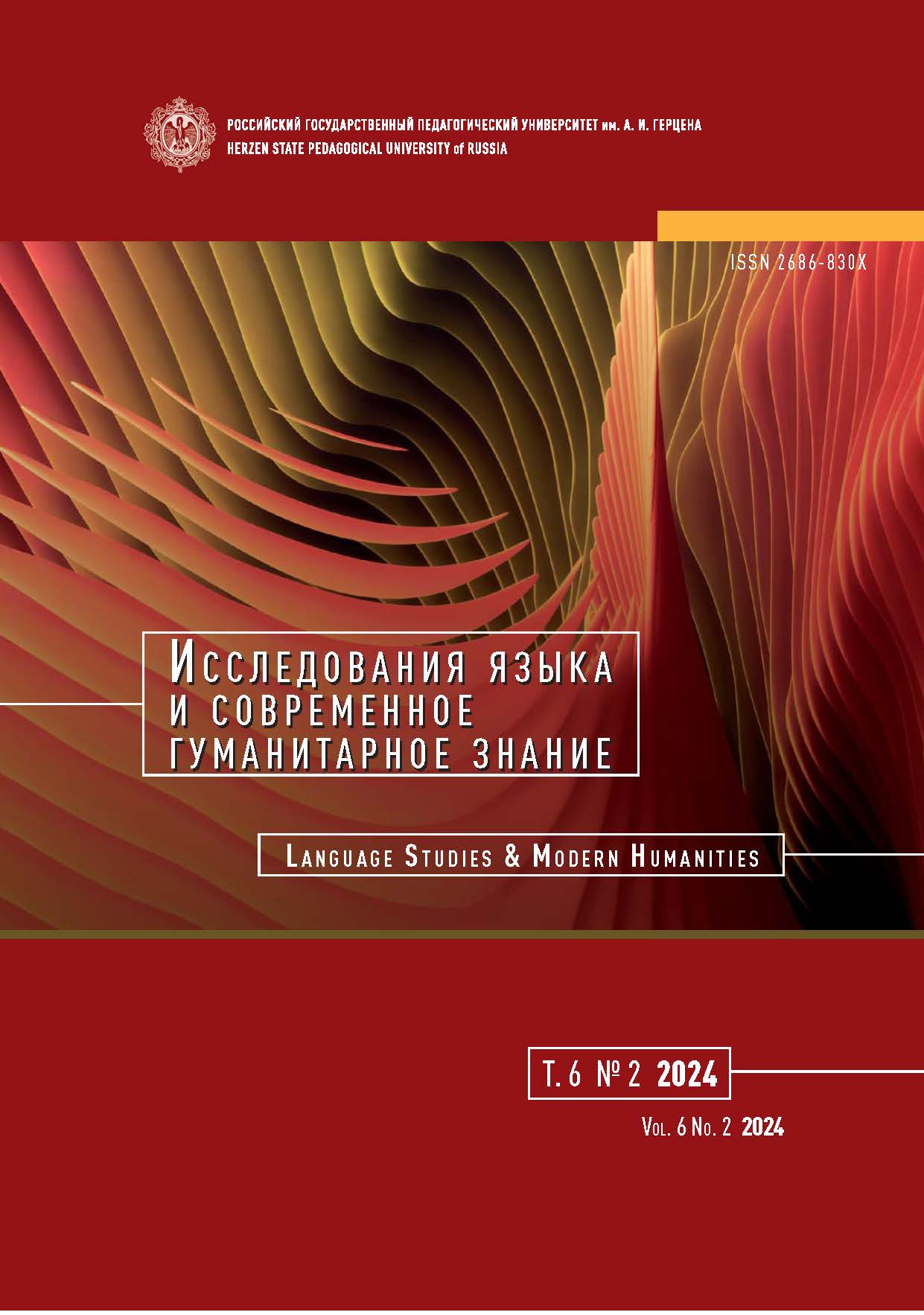Three-vector model of the blogger’s communicative behavior (on the example of a German-speaking popular science YouTube-channel MAITHINK X)
DOI:
https://doi.org/10.33910/2686-830X-2024-6-2-70-84Keywords:
Communication Web 2.0, communicative behavior, communicative strategies and tactics, multimodal ensemble, multimodality, popular science blogging, YouTubeAbstract
The following article is breaking down the multi-step analysis of the blogger’s communicative behavior. “Wissenschaftler irren” — the video from the YouTube-channel MAITHINK X served as a source of practical material for the research. The channel’s content can be defined by the MINT-abbreviation which refers to such fields of knowledge as mathematics, informatics, natural and technological sciences. The analysis is based on the theory formulated by V. I. Tyupa that suggests analyzing social interaction via 3 competences: referential, creative and receptive ones. These competences find its implementation in the sequences of speaker’s actions that are called strategies and tactics. They are aimed at achieving long-term communicative goals as well as speaker’s short-term intentions. In order to sort out and substantiate the means of their manifestation in the blogger’s verbal and nonverbal behavior such factors as communicative means of content generation, means of the narrator’s representation in blogger’s speech besides the means of the recipient factor inclusion should be taken into consideration. The results of the analysis enabled the following description: popular science YouTube discourse is a genre where scientific and social media discourses overlap. It has been ascertained that it tends towards the periphery of scientific discourse, as evidenced by the selection of scientific content, usage of intertextuality tactics, exploitation of argumentative pattern, compliance with the transparency principle of the knowledge acquisition; at the same time its central core belongs to the mass-media discourse which can be judged by the implementation of the self-presentation, dialogization, attraction and retention of attention strategies, usage of the emotionalization and intimization tactics, as well as by the persuasive nature of its content.
References
ЛИТЕРАТУРА
Андреева, В. А. (2022) Коммуникация 2.0: стратегия самопрезентации в немецкоязычном научно-популярном блогинге. Университетский научный журнал, № 69, с. 13–22. https://doi.org/10.25807/22225064_2022_69_13
Андреева, В. А., Копчук, Л. Б. (2020) Научная коммуникация 2.0: особенности представления научного контента на немецкоязычных научно-популярных YouTube-каналах. Научный диалог, № 12, с. 9–25. https://doi.org/10.24224/2227-1295-2020-12-9-25
Москвин, В. П. (2022) Риторика и теория коммуникации. Виды, стили и тактики речевого общения. 4-е изд. М.: URSS, 162 с.
Тюпа, В. И. (2007) Актуальность новой риторики для современной гуманитарной науки. В кн.: Коммуникативные стратегии культуры и гуманитарные технологии: научно-методические материалы. СПб.: Книжный дом, с. 9–73.
Hennig, M., Czicza, D. (2011) Zur Pragmatik und Grammatik der Wissenschaftskommunikation. Ein Modellierungsvorschlag. Fachsprache, vol. 33, no. 1-2, pp. 36–60. https://doi.org/10.24989/fs.v33i1-2.1380
SOURCES
Die Carolin Kebekus Show. (2024) YouTube. [Online]. Available at: https://www.youtube.com/channel/UCw-SjGVT0HK7czJkLgdv3Fw (accessed 25.02.2024). (In German)
MAITHINK X. (2024) YouTube. [Online]. Available at: https://www.youtube.com/@maithinkx (accessed 25.02.2024). (In German)
DICTIONARIES
Cool. (2024) DWDS. [Online]. Available at: https://www.dwds.de/wb/cool (accessed 25.02.2024). (In German)
Dude. (2024) DWDS. [Online]. Available at: https://www.dwds.de/wb/Dude (accessed 25.02.2024). (In German)
DWDS — Digitales Wörterbuch der deutschen Sprache [DDGL — Digital dictionary of the German language]. (2024) [Online]. Available at: https://www.dwds.de (accessed 25.02.2024). (In German)
Info. (2024) DWDS. [Online]. Available at: https://www.dwds.de/wb/Info?o=info (accessed 25.02.2024). (In German)
Klappen. (2024) DWDS. [Online]. Available at: https://www.dwds.de/wb/klappen (accessed 25.02.2024). (In German)
Krass. (2024) DWDS. [Online]. Available at: https://www.dwds.de/wb/krass (accessed 25.02.2024). (In German)
Mega. (2024) DWDS. [Online]. Available at: https://www.dwds.de/wb/mega (accessed 25.02.2024). (In German)
Nerven. (2024) DWDS. [Online]. Available at: https://www.dwds.de/wb/nerven (accessed 25.02.2024). (In German)
Quark. (2024) DWDS. [Online]. Available at: https://www.dwds.de/wb/Quark (accessed 25.02.2024). (In German)
Raushauen. (2024) DWDS. [Online]. Available at: https://www.dwds.de/wb/raushauen (accessed 25.02.2024). (In German)
Scheißen. (2024) DWDS. [Online]. Available at: https://www.dwds.de/wb/schei%C3%9Fen (accessed 25.02.2024). (In German)
Zum Glück. (2024) DWDS. [Online]. Available at: https://www.dwds.de/wb/zum%20Gl%C3%BCck (accessed 25.02.2024). (In German)
REFERENCES
Andreeva, V. A. (2022) Kommunikatsiya 2.0: strategiya samoprezentatsii v nemetskoyazychnom nauchno-populyarnom bloginge [Communication 2.0: The self-presentation strategy in German-language popular science blogging]. Universitetskij nauchnyj zhurnal — Humanities and Science University Journal, no. 69, pp. 13–22. https://doi.org/10.25807/22225064_2022_69_13 (In Russian)
Andreeva, V. A., Kopchuk, L. B. (2020) Nauchnaya kommunikatsiya 2.0: osobennosti predstavleniya nauchnogo kontenta na nemetskoyazychnykh nauchno-populyarnykh YouTube-kanalakh [Scientific communication 2.0: Features of presenting scientific content on German popular science YouTube channels]. Nauchnyj dialog — Scientific Dialogue, no. 12, pp. 9–25. https://doi.org/10.24224/2227-1295-2020-12-9-25 (In Russian)
Hennig, M., Czicza, D. (2011) Zur Pragmatik und Grammatik der Wissenschaftskommunikation. Ein Modellierungsvorschlag [On the pragmatics and grammar of science communication. A modeling proposal]. Fachsprache — Journal of Professional and Scientific Communication, vol. 33, no. 1-2, pp. 36–60. https://doi.org/10.24989/fs.v33i1-2.1380 (In German)
Moskvin, V. P. (2022) Ritorika i teoriya kommunikatsii. Vidy, stili i taktiki rechevogo obshcheniya [Rhetoric and communication theory. Types, styles and tactics of verbal communication]. 4th ed. Moscow: URSS Publ., 162 p. (In Russian)
Tyupa, V. I. (2007) Aktual’nost’ novoj ritoriki dlya sovremennoj gumanitarnoj nauki [The relevance of new rhetoric for modern humanities]. In: Kommunikativnye strategii kul’tury i gumanitarnye tekhnologii: nauchno-metodicheskie materialy [Cultural communication strategies and humanitarian technologies: Science teaching resources]. Saint Petersburg: Knizhnyj dom Publ., pp. 9–73. (In Russian)
Downloads
Published
Issue
Section
License
Copyright (c) 2024 Darina G. Andreeva

This work is licensed under a Creative Commons Attribution-NonCommercial 4.0 International License.
The work is provided under the terms of the Public Offer and of Creative Commons public license Creative Commons Attribution 4.0 International (CC BY 4.0).
This license permits an unlimited number of users to copy and redistribute the material in any medium or format, and to remix, transform, and build upon the material for any purpose, including commercial use.
This license retains copyright for the authors but allows others to freely distribute, use, and adapt the work, on the mandatory condition that appropriate credit is given. Users must provide a correct link to the original publication in our journal, cite the authors' names, and indicate if any changes were made.
Copyright remains with the authors. The CC BY 4.0 license does not transfer rights to third parties but rather grants users prior permission for use, provided the attribution condition is met. Any use of the work will be governed by the terms of this license.







